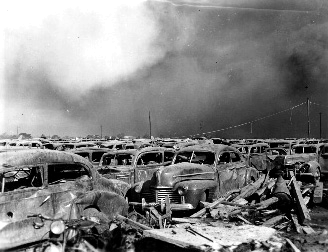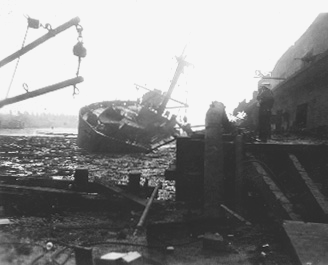The Texas City Disaster
Today's story is about cigarettes and fertilizer. The University of Houston's College of Engineering presents this series about the machines that make our civilization run, and the people whose ingenuity created them.
On April 19, 1995, some murderers parked a U-Haul truck filled with only slightly modified ammonium nitrate fertilizer in front of an Oklahoma City office building. They ignited it, killed 168 people, and injured 600 more. That was 48 years and two days after a far larger charge of the same material had gone off accidentally here in Texas.
Hugh Stephens tells how, on April 16th, 1947, two Liberty ships docked at Texas City on the Houston ship channel -- the Grandcamp and the High Flyer. Both were loading cargoes of that same fertilizer. The Grandcamp held 2300 tons -- the High Flyer, 1000 tons. The rest of High Flyer's cargo was sulfur.
At 8:00 that morning, a small fire broke out in one of the Grandcamp's holds. The ship master tried to suffocate the fire by closing the hatches. He didn't want to use water for fear he'd damage his cargo. At 8:30, the hatches blew and, observers said, a beautiful orange smoke began pouring out. Finally firemen began hosing down the hold. But, by now, the water just vaporized.
At 9:12, a terrible explosion! Pedestrians were knocked down ten miles away in Galveston! People 150 miles away heard the sound. Two airplanes were blown out of the sky. Oil tanks were ignited.
Throughout the day, the extent of the horror unfolded. Fire was everywhere. The nearby High Flyer was burning. At 1:00 AM it exploded even more violently than the Grandcamp had. In the end, some 600 people died and 3500 or so were injured. Property damage ran to billions measured in today's dollars.
How could such a thing happen? No-smoking signs were posted, but who paid any mind to a no-smoking sign in 1947! A cigarette almost surely started the fire. Texas docks had shipped munitions during WW-II under tight military control. Their safety record had been spotless. Now the military was gone. People grew careless. Worst of all, no one seemed to realize that , under the right circumstances, ammonium nitrate fertilizer can become is a vicious explosive.
Some of the terrible fertilizer explosions -- Oklahoma City and the World Trade Center -- were intentional. But I finished high school in the logging town of Roseburg, Oregon the same year Texas City burned. Twelve years later, in 1959, a truck delivering six tons of fertilizer parked overnight in downtown Roseburg. Loggers needed it to blow up large stumps. Lay a sack of fertilizer and a quarter stick of dynamite on a stump -- good-bye stump!
This time, someone dropped a cigarette into a trash barrel next to the truck. The fire detonated the truck at 2:00 AM. Luckily the downtown was almost empty. Thirteen people died nevertheless, and the devastation was total over an area six blocks in diameter.
For half a century, we've feared the atom bomb and high technology. Meanwhile, we suffer these devastating onslaughts, not from hi-tech at all, but from fertilizer and cigarettes!
I'm John Lienhard, at the University of Houston, where we're interested in the way inventive minds work.
(Theme music)
Stephens, H.W., The Texas City Disaster: April 16th-22nd, 1947. Manuscript in preparation as of July, 1996.
I am grateful to Hugh Stephens, UH Political Science Department, for suggesting the topic and providing chapters of his book, and to Thomas Rooke of Roseburg, Oregon, for his personal account of the Roseburg explosion.

Parking lot 1/4 mile from explosion, to right of picture.
Photo courtesy of Special Collections, UH Library

The High Flyer, three days after the explosion
Photo courtesy of Special Collections, UH Library